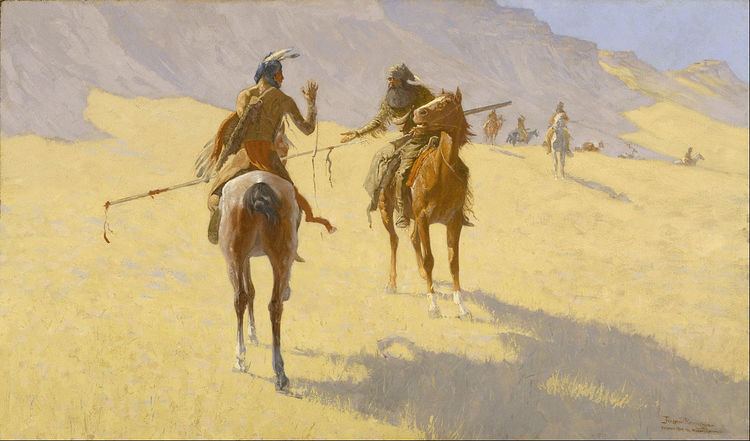 | ||
The word "How" or "Howgh" is a word used as a greeting, or particle in the sense of I have spoken, in some Native American languages, and in their popular representations. It is a part of popular depictions of Native Americans in various novels, e.g. those of James Fenimore Cooper or Karl May.
Contents
Background
The Oxford English Dictionary OED uses [haːʊ̯] ("how") for the spelling, and claims Jean de Brébeuf had described the use of the term as an interjection of approval with the Wyandot (Hurons). De Brébeuf described individual speakers using Condayauendi Ierhayde cha nonhwicwahachen to signify the end of their speaking, which was answered by the community with a long "Hooow".
Longman Webster describes Howgh as greeting of the Sioux; giving "Háu kola" (Hallo friend) as a Lakota Sioux greeting. However, it would be the only Lakota term using a diphthong and is probably of external origin. Dakota and Omaha Sioux use slightly different versions. Francis Parkman, in his book The Oregontrail gives a first-person account of three weeks spent hunting buffalo, with a band of Oglala Sioux, in 1846. He mentions their use of "How". Today, neither in the Hurons, nor the Lakota, use the term, as by 1900 "Good Morning" was the preferred greeting.
Usage
Karl May uses Howgh similar to the Schweizerdeutsch closing particle "Ha gschlosse", which is used by the speaker to indicate they are done speaking. In both cases the term expresses a strict Rule of Order, and a longing for consensus.
Howgh, "Uff!", "Manitou" and Lakota "Hoka Hey" have had a major influence on the Popular image of Native Americans in German-speaking countries. Howgh and pale-face gained popularity as symbols of Native Americans through Cooper's and Parkman's books. By 1917 it was so stereotypically accepted that it found its way into US World War I propaganda depicting Native American soldiers.
(Wilhelm II) killum papoose und killum squaw, so Jo Fixum will find this Kaiser and stickum bayonet clear through. Ugh!
By 1953 it was so completely accepted that in Walt Disney's Peter Pan movie, the song What Made the Red Man Red? uses "How" and "Ugh" with the strong assumption that the contemporary audience would understand them as standard Native American speech.
Howgh found some applications in German songs depicting Native Americans, as in "Indianer" by Nena (lyrics by Carlo Karges) and Gus Backus "Da sprach der alte Häuptling der Indianer" (the old Indian chieftain spoke, covered e.g. by Wildecker Herzbuben and Wirtschaftswunder ). It was even part of the social media parodies of German minister of finance Peer Steinbrück's use of Western movie metaphors against Swiss tax policy 2009. Raymond Steadman was irritated by the usage of what he viewed as a stereotypical phrase, and closed with "Reader gettum sick? Have-um enough?"
